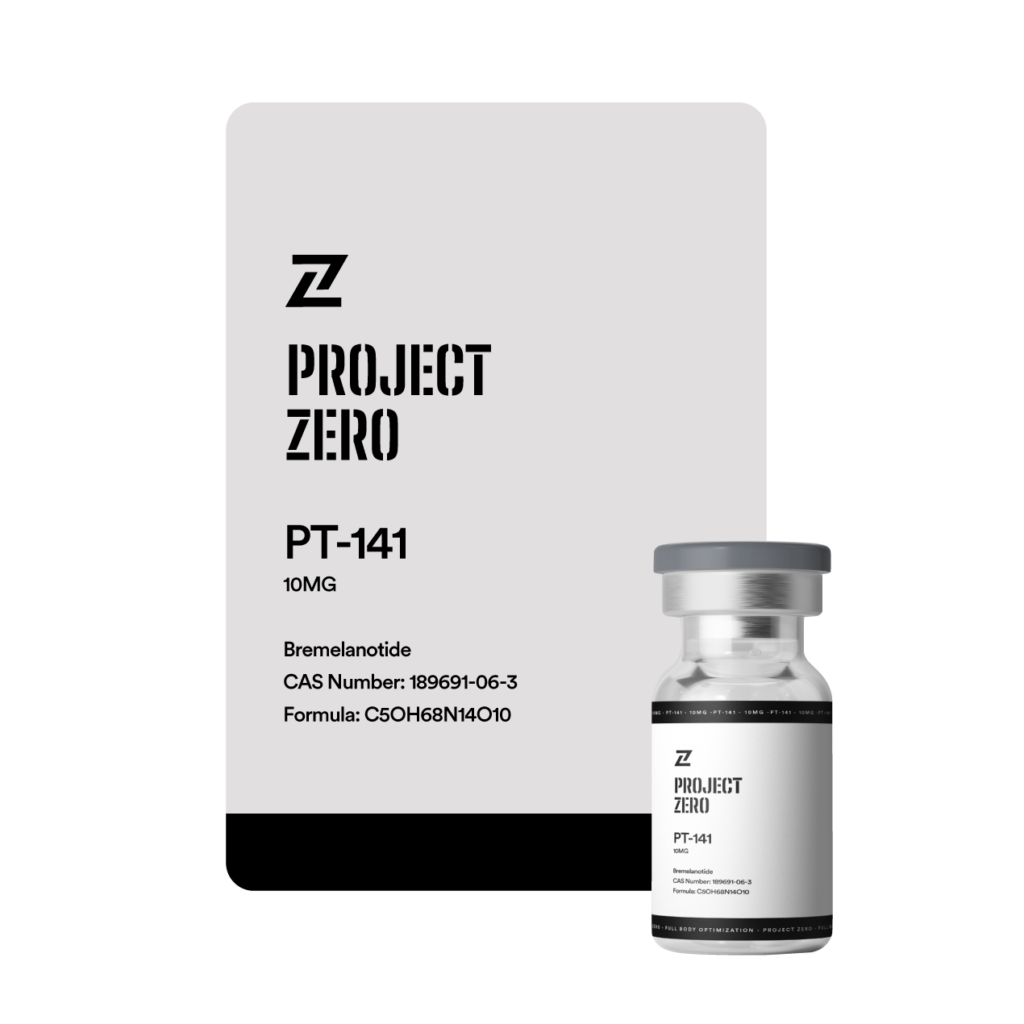PT-141:
Dosage, Benefits,
and Research Explained
PT-141, also known as Bremelanotide, is a melanocortin receptor agonist primarily used to enhance sexual arousal and performance in both men and women. Unlike traditional ED medications like Viagra or Cialis, which increase blood flow, PT-141 directly stimulates the central nervous system, leading to increased libido, stronger erections, and intensified orgasms.
Originally developed as a tanning peptide (a derivative of Melanotan II), PT-141 was later found to have potent aphrodisiac effects, making it a breakthrough treatment for sexual dysfunction and desire enhancement.
Bremelanotide
CAS Number: 189691-06-3
Formula: C5OH68N14O10
| Purpose | Dosage | Frequency |
|---|---|---|
| Libido Enhancement | .5-2 mg As needed | As Needed |
| Erectile Dysfunction | 1-2 mg As needed | As needed |
How It Works
PT-141 activates melanocortin receptors (MC3R & MC4R) in the brain, triggering:
✔ Increased sexual desire (libido boost)
✔ Enhanced arousal & spontaneous sexual thoughts
✔ Stronger, longer-lasting erections in men
✔ Increased sensitivity & pleasure in women
✔ Reduced sexual anxiety & improved confidence
Unlike PDE-5 inhibitors (e.g., Viagra, Cialis, Levitra), PT-141 does not rely on blood flow mechanics, making it effective even for individuals who do not respond to traditional ED treatments.
Research-Backed Benefits
1. Enhanced Sexual Desire & Arousal
- PT-141 boosts libido by activating melanocortin receptors in the brain, increasing natural sexual desire.
- Works for both men and women, unlike traditional ED meds.
2. Stronger, Longer-Lasting Erections
- In men, PT-141 promotes spontaneous, natural erections without the need for direct stimulation.
- Useful for men who do not respond to Viagra or Cialis.
3. Increased Sexual Sensitivity & Orgasms
- In women, PT-141 enhances sexual pleasure, arousal, and orgasm intensity.
- FDA-approved under the name Vyleesi for female hypoactive sexual desire disorder (HSDD).
4. Works Even with Psychological or Blood Flow Issues
- Since PT-141 acts on the brain, it is effective for ED caused by stress, anxiety, or psychological factors.
- Ideal for those who don’t respond to PDE-5 inhibitors (Viagra, Cialis).
5. Possible Tanning Effects (Mild)
- Derived from Melanotan II, some users report mild skin darkening effects.
Conclusion
PT-141 (Bremelanotide) is a revolutionary sexual enhancement peptide that works by stimulating the brain’s arousal centers, leading to increased libido, stronger erections, and enhanced pleasure. Unlike traditional ED drugs, PT-141 is effective even for psychological or blood flow-related sexual dysfunction.
Whether used for ED, female arousal issues, or general libido enhancement, PT-141 offers a powerful, natural way to boost sexual health and confidence.
Disclaimer
This product is for research and educational purposes only. It is not FDA-approved for medical use, diagnosis, or treatment. Always consult a healthcare professional before use.
What is PT-141 (Bremelanotide) and How Does It Work?
PT-141, also known as bremelanotide, is a synthetic peptide that enhances sexual desire by activating melanocortin receptors in the brain. Unlike traditional treatments that focus on blood flow, PT-141 targets the central nervous system to stimulate arousal. It’s FDA-approved for treating hypoactive sexual desire disorder (HSDD) in premenopausal women and is also used off-label for erectile dysfunction in men.
What Are the Benefits of PT-141 for Men and Women?
PT-141 offers several benefits for both sexes:
Enhanced Libido: Increases sexual desire and arousal.
Improved Sexual Satisfaction: Leads to more fulfilling intimate experiences.
Reduced Sexual Anxiety: Helps alleviate performance-related stress.
Quick Onset: Effects typically begin within 30 to 60 minutes after administration.
These benefits make PT-141 a versatile option for addressing various forms of sexual dysfunction.
What Is the Recommended Dosage and How Is PT-141 Administered?
PT-141 is commonly administered via subcutaneous injection. The typical starting dose ranges from 0.5 mg to 2 mg, taken approximately 45 minutes before sexual activity. It’s advised not to exceed one dose per 24 hours or eight doses per month.
Always consult with a healthcare provider to determine the appropriate dosage and administration method for your specific needs.
Are There Any Side Effects or Safety Concerns with PT-141?
While PT-141 is generally well-tolerated, some users may experience side effects such as nausea, flushing, headache, or injection site reactions. These are typically mild and transient.
Less common side effects include increased blood pressure and skin darkening, particularly with frequent use. Individuals with cardiovascular conditions should consult a healthcare professional before using PT-141.
Referenced Citations
- Diamond, L.E., et al. (2004). Double-blind, placebo-controlled evaluation of the safety, pharmacokinetic properties and pharmacodynamic effects of intranasal PT-141, a melanocortin receptor agonist, in healthy males and patients with mild-to-moderate erectile dysfunction. International Journal of Impotence Research, 16(1), 51-59. [Online].
Available: https://pubmed.ncbi.nlm.nih.gov/14963471/ - Rosen, R.C., et al. (2004). Effects of PT-141, a melanocortin analog, on sexual desire and physiological arousal in men and women. Menopause, 11(6 Pt 2), 782-791. [Online].
Available: https://pubmed.ncbi.nlm.nih.gov/15543025/ - King, S.H., et al. (2007). Melanocortin receptors, melanotropic peptides and penile erection. Current Topics in Medicinal Chemistry, 7(11), 1098-1106. [Online].
Available: https://www.ncbi.nlm.nih.gov/pmc/articles/PMC2694735/ - Safarinejad, M.R. (2008). Evaluation of the safety and efficacy of bremelanotide, a melanocortin receptor agonist, in female subjects with arousal disorder: a double-blind placebo-controlled, fixed dose, randomized study. Journal of Sexual Medicine, 5(4), 887-897. [Online].
Available: https://pubmed.ncbi.nlm.nih.gov/18179458/ - Molinoff, P.B., et al. (2003). PT-141: a melanocortin agonist for the treatment of sexual dysfunction. Annals of the New York Academy of Sciences, 994, 96-102. [Online].
Available: https://pubmed.ncbi.nlm.nih.gov/12851303/
